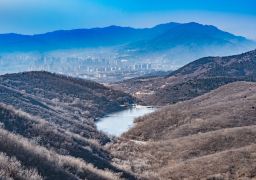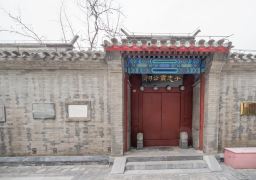Xianglin Jingyuan is located in front of Dacheng Nunnery, adjacent to Yueling Nunnery and the footpath leading to Fayu Temple. It was founded by Monk Miaoquan during the Daoguang period of the Qing Dynasty. Later, it fell into decay due to years of disrepair. It was rebuilt by Monk Juefan during the Guangxu period. At the beginning of liberation, Monks Dehui and Deming lived here. After the ‘land reform’, monks and laypeople lived together. After 1960, the monks left and this nunnery was used as a power plant by the local people. In recent years, the Buddhist Association of Putuo Mountain has renovated it. After reconstruction, Xianglin Nunnery has more than 30 halls and buildings, with a construction area of more than 600 square meters. In the middle of the main hall hangs a golden plaque with the words ‘Jile Baodian’, with its luster remaining as before. The main hall enshrines the ‘Three Saints of the West’, that is, in the middle is ‘Amitabha Buddha’, above there is a plaque with the words ‘Xiangguang Zhuangyan’, on the left is ‘Avalokitesvara Bodhisattva’, and on the right is ‘Mahasthamaprapta Bodhisattva’. According to Master Shijing, the person in charge of Xianglin Nunnery, it is said in the Sutra of Sorrowful Blossoms that in the past there was a chakravartin king. The eldest prince was Avalokitesvara Bodhisattva, the second prince was Mahasthamaprapta Bodhisattva, the third prince was Manjusri Bodhisattva, and the eighth prince was Samantabhadra Bodhisattva. Later, the chakravartin king cultivated and became a Buddha, namely Amitabha Buddha in the Western Paradise. Avalokitesvara and Mahasthamaprapta became the attendants on the left and right sides of their father. Behind the hall, there is an ancient stone tablet with the words ‘Xianglin Chan Courtyard’. It is said that it was erected when this nunnery was first built. It has a history of nearly two hundred years and can also be regarded as a cultural relic. Recently, this nunnery has also invited a precious statue of ‘Master Yinguang’, who was a great master of Putuo Mountain in a generation and was carved from sandalwood, and enshrined it in the reception hall, attracting many Chinese and foreign pilgrims to come to this nunnery for pilgrimage and worship.
Xianglin Jingyuan
Xianglin Jingyuan is located in front of Dacheng Nunnery, adjacent to Yueling Nunnery and the footpa[...]









